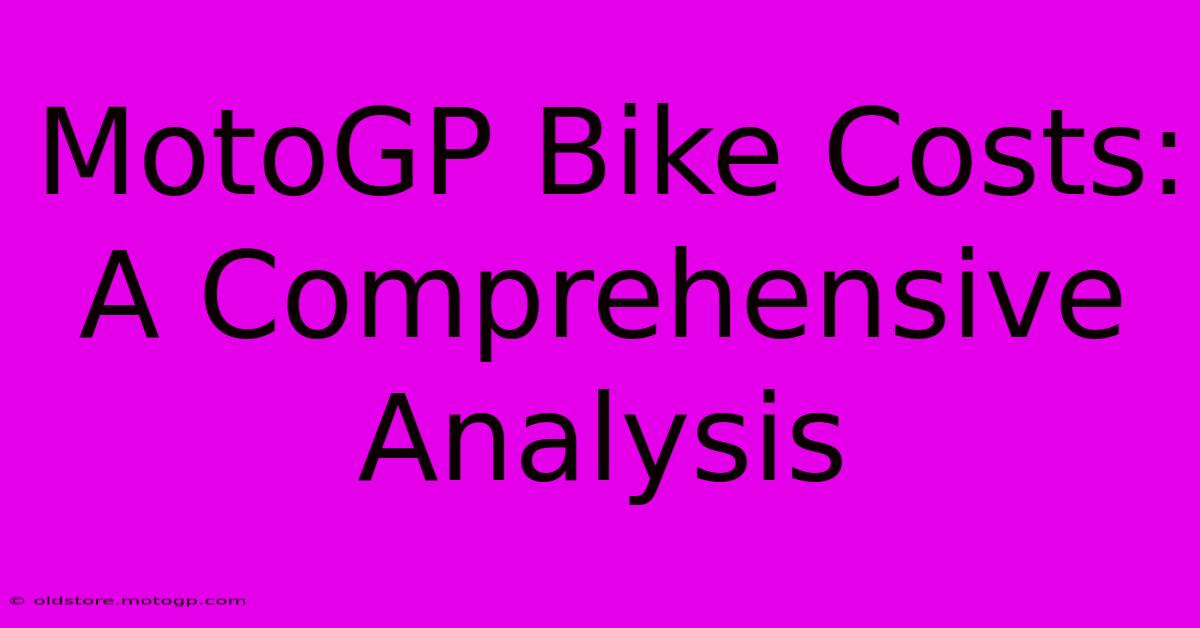MotoGP Bike Costs: A Comprehensive Analysis

Table of Contents
MotoGP Bike Costs: A Comprehensive Analysis
The roar of the engines, the breathtaking speeds, the nail-biting finishes – MotoGP is a spectacle of motorsport at its finest. But behind the glamour and the glory lies a significant financial investment. This article delves into the complex world of MotoGP bike costs, exploring the various factors contributing to the astronomical price tag of these technological marvels.
The Price Tag: More Than Just a Motorcycle
It's impossible to give a single definitive figure for the cost of a MotoGP bike. Unlike road-going motorcycles with readily available price tags, these machines are not commercially sold. They are bespoke creations, meticulously engineered and constantly evolving. Estimates place the cost of a fully-fledged MotoGP prototype in the range of $2 million to $3 million USD or even more. This is just the initial investment.
Factors Influencing MotoGP Bike Costs:
Several factors significantly inflate the cost of a MotoGP bike:
-
Engine Technology: The heart of any MotoGP machine is its incredibly powerful and sophisticated engine. These engines are not mass-produced; they are handcrafted, utilizing cutting-edge materials and technologies like seamless shift transmissions and sophisticated electronics for unparalleled performance. The research, development, and manufacturing of these engines alone account for a substantial portion of the overall cost.
-
Chassis and Aerodynamics: The chassis is meticulously designed for optimal handling and stability at breakneck speeds. Advanced materials like carbon fiber and titanium are used extensively, adding to the cost. The aerodynamic components, including winglets and fairings, are also crucial for performance and undergo constant refinement through wind tunnel testing and computational fluid dynamics (CFD) analysis. This R&D process is incredibly expensive.
-
Electronics and Data Acquisition: Modern MotoGP bikes are heavily reliant on sophisticated electronics. This includes sophisticated engine management systems, traction control, wheelie control, launch control, and an array of sensors that collect vast amounts of data. The data acquisition system is critical for analyzing performance and making adjustments. The cost of developing and integrating these systems is substantial.
-
Research and Development (R&D): The continuous development and improvement of MotoGP bikes are an ongoing process. Teams invest heavily in R&D, employing engineers, technicians, and designers to push the boundaries of motorcycle technology. This constant evolution ensures competitive advantage and adds to the overall cost.
-
Materials and Manufacturing: The use of premium materials like carbon fiber, titanium, magnesium, and other high-performance alloys contributes significantly to the cost. The precision manufacturing processes required to build these bikes also demand specialized equipment and highly skilled labor.
-
Team Personnel: The cost of employing highly skilled engineers, technicians, mechanics, and other personnel involved in the design, construction, and maintenance of a MotoGP bike is substantial. Their expertise is crucial to ensuring peak performance and reliability.
Beyond the Initial Cost: Ongoing Expenses
The initial cost of a MotoGP bike is only the tip of the iceberg. Ongoing operational costs include:
-
Maintenance and Repairs: The high-performance nature of these machines means regular maintenance and repairs are essential. This requires specialized tools, parts, and expertise.
-
Spare Parts: The need for spare parts during races and testing adds to the expenditure. These parts are often custom-made and expensive.
-
Transportation and Logistics: Transporting the bikes and equipment to various race circuits worldwide is a major logistical undertaking and adds significantly to the budget.
-
Tyres: MotoGP teams consume a considerable number of tires per race weekend. The cost of high-performance tires is substantial.
Conclusion: A High-Stakes Investment
The cost of a MotoGP bike is a testament to the cutting-edge technology, meticulous engineering, and intense competition within the sport. While the exact figure remains elusive, it's clear that these machines represent a massive investment that goes far beyond the initial price tag. The ongoing costs, including R&D, personnel, and maintenance, further illustrate the high-stakes nature of MotoGP. This comprehensive analysis highlights the multifaceted factors that contribute to the exorbitant cost of these technological marvels, solidifying MotoGP's position as one of the most expensive and technologically advanced motorsport disciplines in the world.

Thank you for visiting our website wich cover about MotoGP Bike Costs: A Comprehensive Analysis. We hope the information provided has been useful to you. Feel free to contact us if you have any questions or need further assistance. See you next time and dont miss to bookmark.
Featured Posts
-
Moto Gp Live Free Your One Stop Shop For Free Moto Gp
Feb 24, 2025
-
Unlocking Speed The Power Behind Moto Gp Bikes
Feb 24, 2025
-
Moto Gps Unsung Heroes Recognizing The Underrated
Feb 24, 2025
-
The Future Of Racing Exploring Moto 2 Specs
Feb 24, 2025
-
Who Dominated Qualifying Moto Gp Results Analysis
Feb 24, 2025
